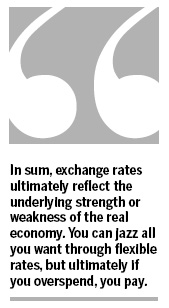Op-Ed Contributors
Waltzing around exchange rates
By Andrew Sheng (China Daily)
Updated: 2010-03-05 07:51
 |
Large Medium Small |

As the textbooks say, money is a means of exchange, a unit of account and a store of value. When we discuss foreign exchange rates, we mean the value of our currency against a foreign benchmark. Since there are many such benchmarks or standards, we use the most common one, which is the US dollar. This is because the US dollar is the most widely used reserve currency, accounting for roughly two-thirds of global foreign exchange trading and official foreign exchange reserves.
| ||||
You will find it difficult (at times impossible) to exchange our currency in many parts of the world. But that will not be the case with the US dollar. The greenback is the reserve currency standard because it meets all the conditions of an international unit of account, means of payment and store of value.
But with the US running unsustainable current account deficits and its net foreign debt growing, its dollar faces structural depreciation, creating uncertainty on a global scale. The real problem stems from the fact that all foreign exchange rates are relative and not absolute values. Value is relative not only against real goods, but against other paper currencies too.
If we use a metal as standard, such as gold, and the quantum of gold remains static as the global demand for liquidity increases, then prices will be deflationary. The gold standard was found to be too strict to adhere to, because if all currencies were linked to gold, you could run a fiscal or trade deficit without huge outflows of gold.
The advantage of using a paper currency is that the supply can be adjusted to the national or global needs. As monetarists claim, inflation is basically a monetary problem of printing too much money. Money can be printed through growing fiscal debt, growing bank credit or inflow of foreign funds.
You can print domestic currency notes, but not foreign ones. In other words, you can ask your fellow countrymen to bear an inflation tax by printing money, but foreigners (and today locals) could run through capital outflow. They stop investing and lending money and you end up with a fiscal or currency crisis.
The bottom line is that in the long run, you cannot spend more than what you earn. Thus, when conventional economists say that flexible exchange rates help with monetary policy, they think there is an easy way out of this problem.
Flexible exchange rates may help a little in day-to-day adjustments in prices, but ultimately, there is always the temptation to use the exchange rate to devalue your way out of the fundamental problem of spending more than you earn.
This is exactly what the Greek tragedy is all about. Greece is part of the European Union (EU), which uses the Maastricht Treaty rules to stop member countries from printing too much currency notes to ensure that the euro maintains a stable value. The Maastricht rules draw the line of the annual fiscal deficit at not more than 3 percent of GDP and total fiscal debt at 60 percent of GDP. The Greeks ran a fiscal deficit of more than 12.7 percent in 2009. Their total fiscal debt now is at 120 percent of GDP.
The Greeks hid the deficits for more than 10 years by using various tricks, including using investment bankers to do swaps. In the 1990s, leading investment banks were fined in Japan for helping Japanese companies and banks hide their losses. Now they have become bold enough to help governments hide their deficits.
Putting it bluntly, neither fixed nor flexible exchange rates can hide the fact that if a borrower, whether it's a company or a government, spends more than it earns, its day of reckoning will come soon. Fixed exchange rates are a discipline - profligacy will show up very fast.
Flexible exchange rates use a weaker currency to try and earn more exports. But if the cause of overspending is the government aided by loose monetary policy, then sooner or later foreign countries will stop lending or investing. You cannot jazz your way out of overspending. Sooner or later the music must stop.
The Greeks thought that once they were in the EU other Europeans would bail them out - that is, non-Greeks would pay for their over-spending. Since Greece cannot devalue the euro by itself, then the pain of adjustment must be done on the fiscal or employment side. In other words, a fixed exchange rate ultimately forces the structural adjustment. The Europeans are asking Greece to make that adjustment as a condition of help.
We cannot think about exchange rates as only a bilateral affair, that is, between currency A and currency B. Before the Asian financial crisis, East Asian currencies were mostly benchmarked against the US dollar, some being fixed and others floating. Nevertheless, each currency had some kind of parity against each other. For example, before the crisis in 1997, the Malaysian ringgit was roughly 2.5 to 1 US dollar, and the Thai baht, Filipino peso and the Taiwan dollar 25.
In other words, they adjusted at roughly 1 or 10 to each other. This made it very convenient to do business across East Asian borders, especially because of trade competitiveness. The central bank of every country knew that if the rates moved out of line not only against the US dollar, but also against the neighbors, trade competitive issues would arise.
This regional pattern of currencies "waltzing against each other" in a stable pattern unless disrupted by crisis was formed by the underlying "Asian global supply chain". After the Asian financial crisis, when most currencies were floating, the same pattern emerged because the underlying needs of the "Asian supply chain" forced some competitive stability between the linked exchange rates. In sum, exchange rates ultimately reflect the underlying strength or weakness of the real economy. You can jazz all you want through flexible rates, but ultimately if you overspend, you pay.
The writer is the author of the book, From Asian to Global Financial Crisis.
(China Daily 03/05/2010 page10)












